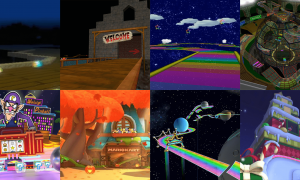We’ve all been there. Scrolling through the cups, furiously trying to decide the best track to select as the timer runs its own course. There are so many variables that can alter your decision. What position did I earn last race? Should I pick this track because it’s one of my favorites? Or maybe I should pick this instead because it’s very popular at the moment? Actually, I haven’t been getting good spots on that track recently, so I should consider something else. No one picks this, so maybe it’ll catch them off guard? But I can’t pull off that shortcut consistently… So I think I’ll just pick this as it is safe.
48 tracks, on paper, might seem as though they would become stale fairly rapidly, especially considering that, for those who started playing since vanilla Mario Kart 8, they have been racing on these tracks for over 6 years at this point. Yet, bear in mind that in most Mario Kart tournament formats, one will usually play 8 or 12 races per match or round. This means in one individual sitting of play, you’ll likely only be experiencing a quarter or less of the total track pool. In addition, unless all participants select the same course, track selection is random, resulting in a marked difference between picking a track and playing a track. Factoring in the possibility of a track being picked from the pool of 48, and then being selected in the roulette over 12 votes from all players, over 12 races, plus the potential for a track to be repicked 11 times, there are an absurd 331,776 possible combinations of tracks in such a format.* Of course, there are factors that can narrow down the possibilities, such as voting with your team in 6v6 or multi-team formats, but the sheer quantity of track combinations is an aspect that serves to keep Mario Kart fresh and exciting.
Still, there is no doubt that our own preferences and perceptions on this game’s courses shape how we play the game in the current day, even if these thoughts tend to shift and adapt in the moment. A little while ago, I asked members of the community to rank all of the tracks based on how often they thought they played those tracks, across all tournament and casual play. Meanwhile, Boo Bombs member SirBubbleChu asked members of the community to select their top 5 and bottom 5 favorite tracks, utilizing a points-based system to equally weigh the number of votes for and against the tracks to comprehensively rank them from most to least popular. By collaborating on these findings, we might be able to determine whether there is any correlation between a track’s popularity, and its perceived place in the current ‘meta’ of tracks.
We will commence with my own survey first. I asked participants to rank all 48 tracks based on how often they saw that track across all forms of Mario Kart play. The website would display two tracks, and participants chose which course they thought they saw more regularly. Rinse and repeat several times, until a comprehensive list is produced. I then took these full course lists and calculated the mean position each course received. The results are as follows:

To many that have been involved as players or spectators in the Mario Kart tournament scene for some time, a sizable quantity of the perceived most common and least common tracks will come as little surprise. But it is no doubt worth reiterating the functions of some of these tracks that place them in the positions they are, especially to those fresh to the scene and seeking some guidance into potential tracks to pick up.
For example, DS Wario Stadium almost certainly earns a spot at the top of the list as a staple track for picking when you are dominating the top spots. This can be attributed to two key characteristics of this track. Firstly, the paths of the track are very thin, and conjoin many twists and turns. The three straightaways in the track are also far from passive experiences, requiring navigation of boost panels, the transition off a ramp into underwater, or a glider. The effect of this layout is a course that rewards tight lines around bends, and trapping unknowing players behind you with well-placed bananas or backed shells, on top of performing certain drifting and handling strategies, which can great assist in breaking away compared to the players unaware or unable to emulate them. Secondly, there is still a sense of accessibility of Wario Stadium that makes it agreeable across a wider scope of players. Aside from the anti-gravity section there is nowhere to fall off the track, and the tight turns can also produce thrilling pack-based situations, where managing a decent turn next time might net the player several key overtakes. It is one of the few frontrunning tracks that adopts an ‘easy to play, hard to master’ approach.
Meanwhile, Dolphin Shoals’ position can likely be attributed to its uniqueness as an ‘anti-1st’ track. In contrast to Wario Stadium, the relative wideness of the course at the beginning, combined with the straightaways and the application of water speed, fosters the capacity for multiple drafts to propel past the leaders very quickly. Overtaking is also very viable on the eel, with well-executed multi-tricks. Yet, the anti-1st status does not just apply to the opening. Using a bullet bill either after the first turn or just before the eel produces absurdly long periods of use to bring a player right back into the front, and the potential for a thundershock to target top spots over the glider or initial cave sections is a constant threat. Overall, it is a course that, whilst predominately anti-1st in nature, does allow players some berth to adapt their strategy on the fly. Interestingly, the chief alternative to Dolphin Shoals, Electrodrome, did not assume similar frequency, at tied 14th.
And from common to ultra rare, let us talk about the least commonly seen track: normal Mario Circuit. After some careful thought, I could supply two possible reasons this track is virtually never booted up. One is that it lacks tangible benefits to any approach. Frontrunning the track is difficult as the two shortcuts can cut off enough space to place first in contention, yet the staggered nature of the two main shortcuts and further cutoff points means that using mushrooms and stars to clear one might leave you with no means to clear the next, unless you are significantly far behind. Therefore, this tends to lead to a gamble among the pack for mushrooms for the final shortcut, a gamble that is not quite as controlled as on tracks such as Dry Dry Desert or Cheese Land. Two, beyond the near-constant anti-gravity, the track is relatively no-thrills, severely lacking in the flashy technical displays that are readily abundant in several of the higher ranked tracks.
Now, moving on to SirBubbleChu’s survey. He asked all participants to select their top 5 favorite tracks, and top 5 least favorite tracks. Beforehand, he asked participants to select how they play the game (time trialing, competitive play, casual play etc.) and the MKU division they play in or perceive their skill level to be at. The full list of tracks are then displayed twice, allowing the participant to select their top 5 favorites in one list, and their top 5 least favorites in the next list. As aforementioned, SirBubbleChu used a points-based system that added points for favorite tracks, subtracted points for least favorite tracks, and did not add or subtract points to tracks not selected. He produced three full lists from his data: One which positioned tracks based on most to least votes as a favorite track, one which positioned tracks with the most votes as least favorite tracks, and a final list averaging the points between favorite and least favorite votes to produce a comprehensive list of the most and least popular tracks.
Let’s start by briefly observing the first two lists. The first is the tracks with the most votes as favorite tracks:
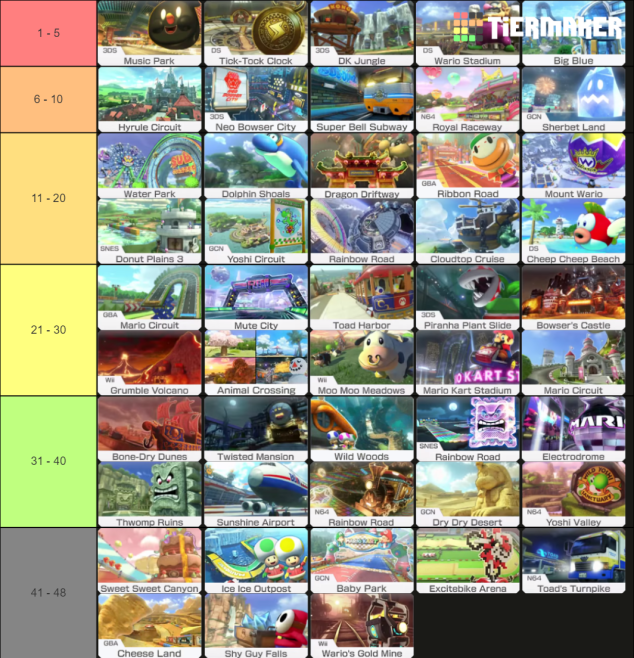
Already we can begin to draw some correlations between some tracks that received among the most votes as a favorite track compared to how commonly they seem to be picked, tracks such as Music Park, Tick-Tock Clock, and of course Wario Stadium. Similar trends can be seen on the other end of the spectrum, with Shy Guy Falls, and the notorious Baby Park and Toad’s Turnpike.
Curiously, a couple of courses seem also to be bucking the trend immediately. Take Big Blue, for instance. Relatively middling in terms of track pick frequency, it appears the F-Zero track harbors a decent chunk of fans. For sure, it is one of the most ambitious designs for a Mario Kart setting, packing plenty of fast-paced, roller-coaster like turns, boost pads and panels, and a kick-ass remix of the signature Big Blue theme. It has wildly daring shortcuts that are not necessarily too high-risk, but still feel quite epic to pull off, and sectioned tracks tend to provide a breath of fresh air out of the conventional 3-lap system. Its place as a pick is a little distorted, though, likely attributed to the glider section into Section 3 – it tends to give away many big power items, even to players in high spots. This can turn the final bends into a measuring contest of who has the biggest weapons at their disposal to batter those who are unarmed and underprepared. Big Blue, then, likely bucks the trend, as a track that’s very fun to race, but tricky to muster favorable outcomes with, at least without some thorough experience.
Then there is another infamous slice, Cheese Land. 6th in frequency, a measly 46th as a favorite track. Often seen as the secondary pick to Dry Dry Desert (another track not faring well as a favorite), Cheese Land is a hardcore bagging and power item hoarding track, thanks to its huge final shortcut and another culprit of insane bullet bill strategies in combination with thundershocks. It is an ideal track to select after a sub-par race as it denies those in top spots an opportunity in a frountrunning track, yet the wildly unpredictable nature on the board of tracks like Cheese Land is undoubtedly a key contributor to lacking in a player’s good books. A prime example of a course that is almost always necessary, but tends to just be tolerated for the sake of making progress.
Next are the least favorite tracks, with 1 having the least ‘least favorite’ votes and working downwards to the most ‘least favorite’ votes at 48:
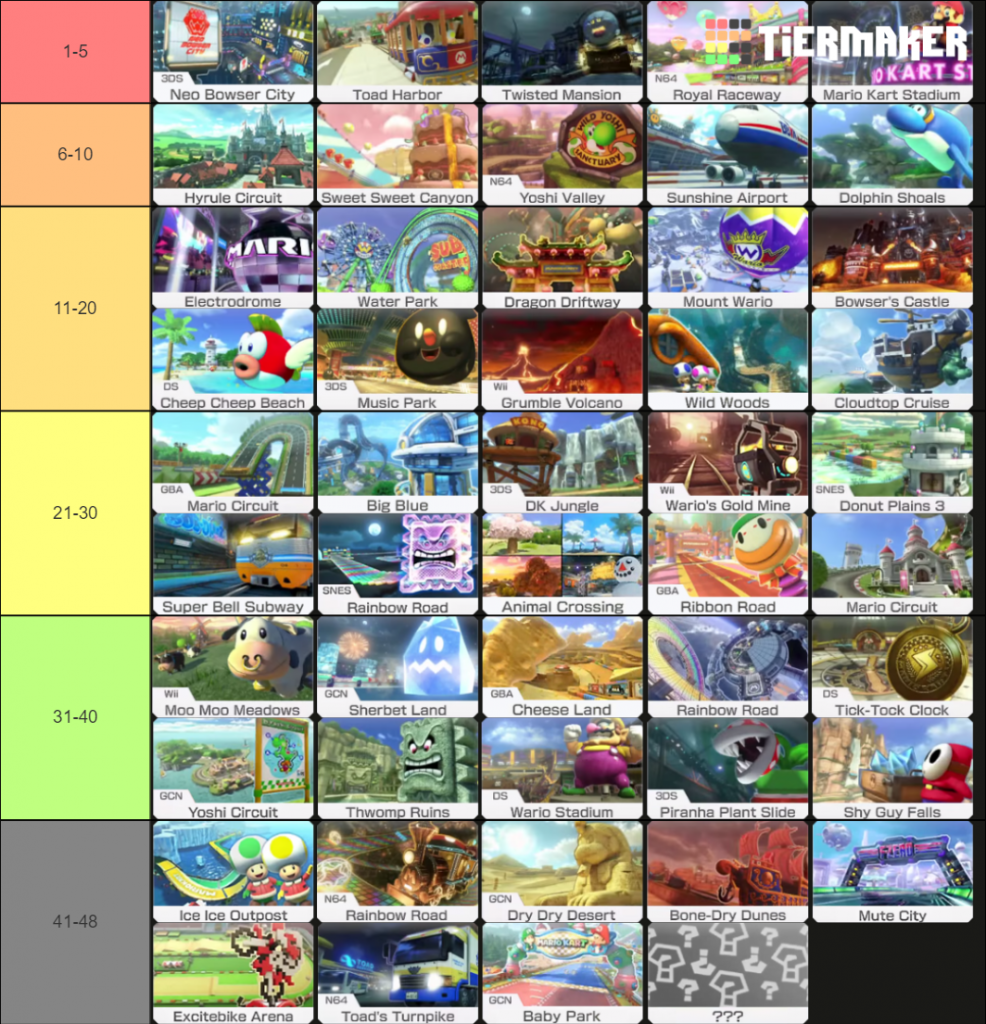
The bottom side of the list, the most disliked tracks, are still not especially eye-opening, considering we have just seen a similar sample of the same as receiving the least ‘favorite track’ votes, and tend to fare either low or middling in frequency as a pick. Wario Stadium and Tick-Tock Clock are clear exceptions, however. Perhaps I was incorrect in assuming Wario Stadium’s role as an accessible frontrunning track? This is possible, but another possibility is that the sheer quantity of its selection could be somewhat wearying. Tick-Tock Clock might also fall under this category, and aided by the difficulty of the thin clock-hand shortcuts as a frustration point. Also of note is the placement of the aforementioned Cheese Land and Dry Dry Desert on the list, supporting our theory that the tracks are simply a necessary commodity over a source of enjoyment.
A gander on the top of the list, however, and a handful of the courses are initially perplexing – Toad Harbor, Royal Raceway, Mario Kart Stadium, even Yoshi Valley and Sweet Sweet Canyon all see either just above average or fairly below average perceived play. Upon attempting to dissect why these tracks were rarely actively disliked, however, I noticed some marked similarities. Namely, all of these courses are very ‘safe’ to drive. Each of them have very few points at which a player can fall off, either through heavy use of guard rails or the shaping the of the track naturally deterring people from falling unless they significantly veer away from the standard paths. All of these courses have a small, but vital shortcut on their final bend, so even players who been bullied into, or intentionally played from the back always have a chance to steal away a decent spot in the closing moments. That being said, the low-risk nature of these tracks also creates a solidly satisfying frontrunning experience, too, especially as the former three tracks contain reliable but effective no-item shortcuts, and the latter two contain alternate paths that can add a layer of depth into deciding your optimal lines on the fly. In short, these tracks are likely lacking in disapproval due to their adaptive and forgiving layouts, which are highly accessible to virtually all brands of player.
And finally, we reach the core of SirBubbleChu’s findings, combining both the points from both positive and negative votes to piece a definitive list of tracks, from most to least popular:
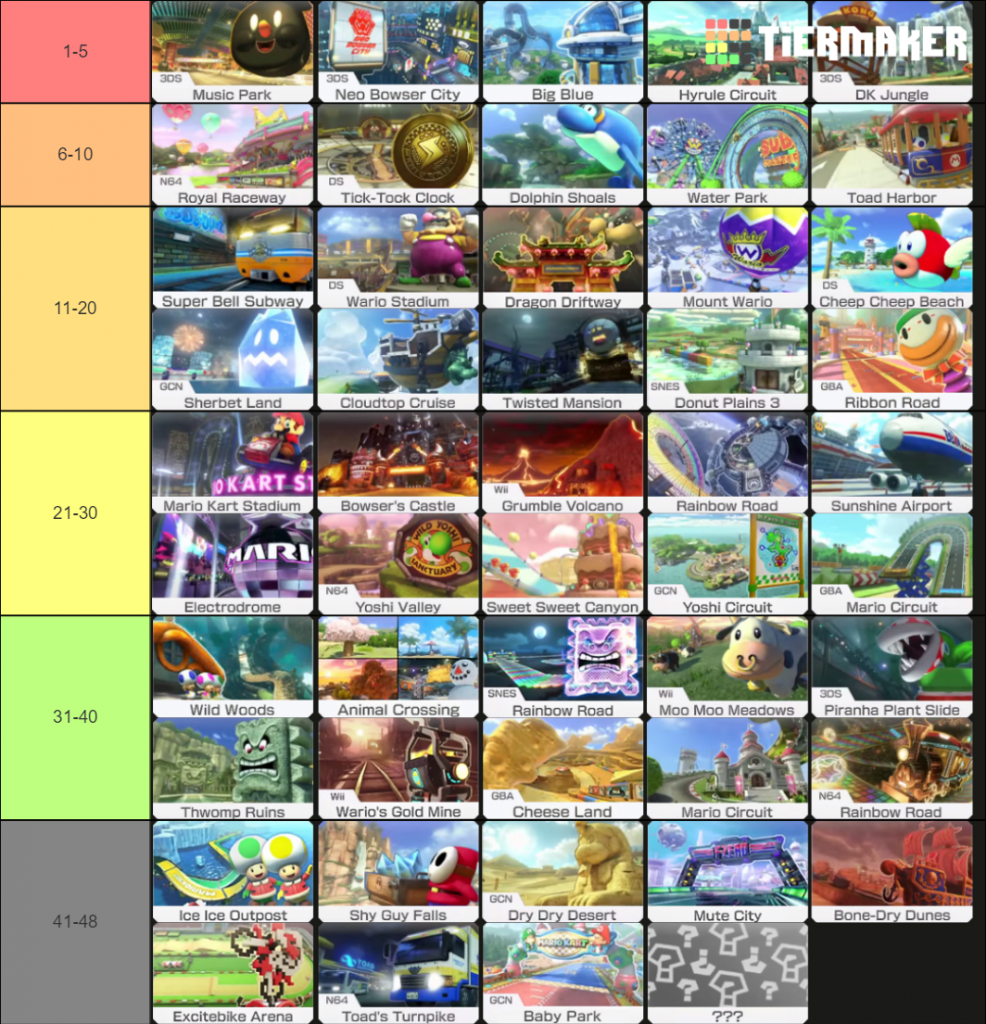
Not too surprising overall, considering this is a combination of our previous lists, and we have previously discussed some of the noticeable anomalies. Four of the five top tracks are frontrunning focused, and three of the courses in our bottom set are catchup focused. This would suggest players gain considerable enjoyment from the satisfaction of successfully and skillfully navigating courses at the front of the pack, over the clustered and frantic nature of playing from the back.
And now that we have the comprehensive list of the most popular tracks, we can now combine this data with the most and least picked tracks to present a complete graph:
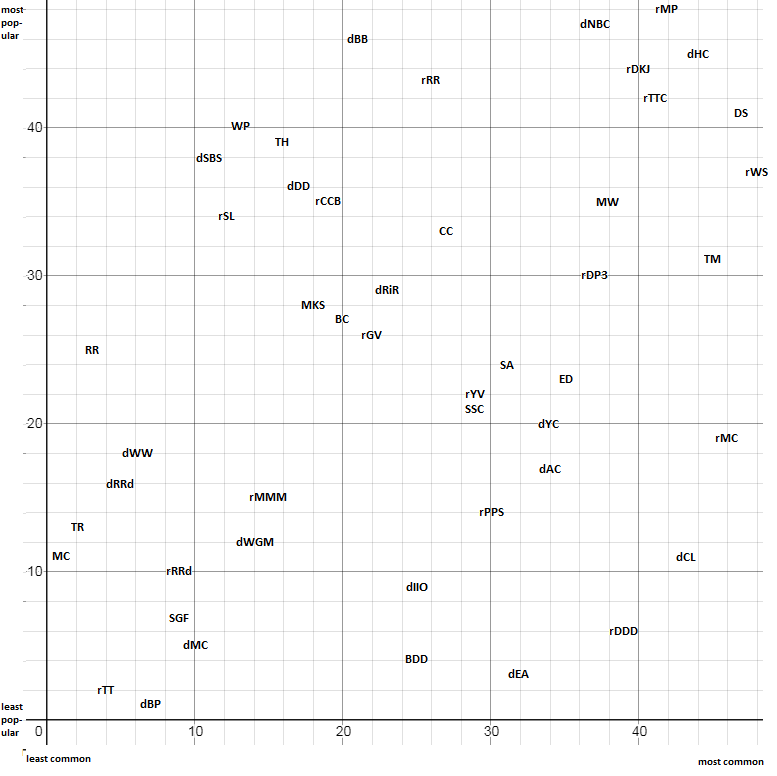
Let us now return to the original question: Is there any correlation between track popularity and how commonly a track is picked?
An initial glance at this graph would suggest this is not the case. One might expect a tandem increase between popularity and commonness, yet only a handful of courses seem to facilitate this trend (of all the courses, only Moo Moo Meadows had the same result in popularity and rate picked, at 34th). With this in mind, however, looking at the bigger picture might not be ideal, especially as both mine and SirBubbleChu’s surveys asked participants to provide their thoughts based on subjective opinions over any objective components. Instead, it might instead be worth looking at clusters of tracks within certain squares of the graph. For example, in the top-right side, seven tracks have a marked gap from any other cluster, marking them as the very favorable and worthwhile across the board (again, worth noting that six of the seven are frontrunning courses, with Dolphin Shoals as our aforementioned breakup course). Meanwhile, the bottom-left four squares contain eleven courses, which support the theory that a disliked course is also rarely played, whether that be from notoriety from selections such as Baby Park or Toad’s Turnpike, or courses such as Thwomp Ruins or Wild Woods that never quite found, or have a very niche part in tournament play and beyond. Finally, notice the curve that can be formed out of the four bagging/catchup tracks in the bottom right corner; one could almost consider it a priority list for that brand of courses.
It is the courses in the middle where we find the most discrepancies, but there does seem to be two noticeable clusters: Tracks which are in the upper-middle half of popularity tend to fall into the lower-middle half of commonness, and vice versa. Let’s analyze a couple of tracks from both clusters to see if we can spot any rationale behind their placements:
Water Park can certainly be considered to fit into our ‘no-thrills’, accessible driving category, with the only chance of falling off being at the glider with extreme tilting, and it contains one very small shortcut in its underwater section. So how come it fared better, popularity-wise at least, compared to similar courses in its band? It actually likely comes down to its lack of pick rate, combined with its simplicity. Its lack of play likely meant it went undetected in terms of an actively disliked course, instead paving the way for fans of the track to leave a bigger impact with its positive votes.
Meanwhile, Dragon Driftway’s spot can likely be attributed to having one of the most difficult no-item shortcuts in the game, requiring a precision ultra-mini turbo and hop over a sizable gap before the bridge. However, the key difference between this and Shy Guy Fall’s shortcut is that in Dragon Driftway’s case, the cut is early enough in the track that failing it does not necessarily spell a death sentence for the remainder of the race. Therefore, it is likely skipped over by a majority of players that do not have practice or relative confidence in taking the shortcut, but picked by those that have honed in on practice, or can use back-up strategies for failed attempts at the cut.
Turning to the other side of the spectrum, let’s look at Piranha Plant Slide, Ice Ice Outpost, and Bone Dry Dunes as a collective, because all three of them share some eerily similar qualities. All of them are long, winding courses, with some elements of off-road or sliding physics in parts. Even more bizarrely, all three of them end the exact same way, too – a glider section into a final turn containing a high-risk shortcut that has the potential to earn a player a lot of last-second overtakes. All three of them are fairly trap-friendly where there are thin corridors to stack bananas or back shells, making for smooth frontrunning choices. But the chance for a target shock over a glider, denial of the final shortcut from a bomb or boo, or general crowd control in the pack from boomerangs or fire flowers can make these tracks especially frustrating at key moments, turning the tide of what might have seemed a sure high spot. Perhaps, then, they are to be considered the ‘back-up’ or ‘risky’ frontrunning selections, with potential to be utilized well in the right hands, but lacking in the safety nets from the Wario Stadiums and Hyrule Circuits of the pole position preferences.
Now that we have presented all of the data, and put forward some deeper analysis on a handful of courses, we are now able to discuss what may be the underlying cause acting as the foundation for determining these results: Utility. Utility is difficult in some ways to pin down in a quantifiable way, because there is utility in the sense of your own inputs and ability on the controller in response to the track, and the track itself, the visual and aesthetic representation for the driving mechanics being put to the test. The tracks that are favored in both popularity and commonness are where they are because they offer such high utility both on and off-screen, being satisfying to drive from the execution from the player’s driving and item-based input, in conjunction with how smooth the plays look on the course itself. That is not to suggest that the remaining courses lack any sort of viable utility at all, but the utility is either not quite so widespread or consistent, or must be approached with a differing toolkit to unlock the potential for frequency or player satisfaction. In another sense, utility is also control for the player. When the player feels under control relative to the track presented to them, but also challenged by the possibility of many varying outcomes, the player reaches a sense of flow, which is highly impactful on the player’s perceptions of the courses. Of course, getting such a feeling from a track is still highly personal and subjective, but over time, as the Mario Kart 8 Deluxe community pushed and tested the boundaries of the courses on all fronts, the courses that stood the test of time in terms of general enjoyment, and/or out of use or purpose, took shape into what we have discussed today.
Still, even though Mario Kart 8 Deluxe has been released for over three years, there is always the chance for new track-based revelations to be made and established. Could you be the person that changes the way we think about that track? Only one way to find out!
* fun fact: If you take any 12 tracks and place them in any order, the odds of getting your exact combination of tracks in the exact same order are 1 in 33371339479827148800. Please thank my teammate gdin as well as Vike for blowing my mind with this information…

